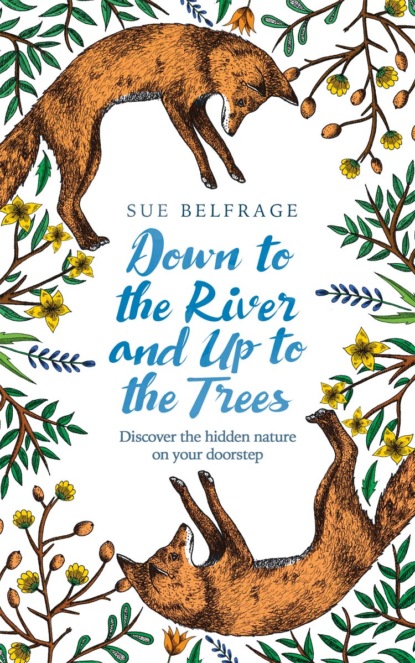По всем вопросам обращайтесь на: info@litportal.ru
(©) 2003-2024.
✖
Down to the River and Up to the Trees: Discover the hidden nature on your doorstep
Автор
Год написания книги
2019
Настройки чтения
Размер шрифта
Высота строк
Поля
While there are weeds such as hemlock and poison ivy that you wouldn’t welcome into your living space, others can bring benefits. Some weeds help check soil erosion and add organic matter and nutrients to the soil, while others with long roots can help break up compacted ground – the weed equivalent of earthworms.
The shrub buddleia can seed itself, weed-like, in wasteland, and is known as the butterfly bush for good reason. In summer, buddleia can become a fluttering heaven of butterfly wings as the insects flit about, sipping on the flowers. Even ivy, often ripped off walls and trees, is an important food supply for honeybees and birds in the autumn because of its late flowering season and calorie-rich berries.
If washed and prepared, weeds can be nutritious for human beings too. Add hot (not boiling) water to cleavers, also known as goose grass, for a medicinal cup of herbal tea that’s good for the digestive system. Or make yourself a salad from young dandelion leaves or chickweed, with its tiny white flowers. For a hot dish, sauté nettles, chickweed or sorrel with a little garlic and olive oil, and serve with a drizzle of lemon.
‘A weed is but an unloved flower.’
ELLA WHEELER WILCOX (1850–1919), ‘The Weed’
Colour Quest (#ulink_f05191c8-ceed-575c-babd-f4806ca874dd)
While it might not always seem like it on an overcast day, nature is bursting with colour. Even if you look closely at a cloud, you will notice different hues – pale pinks and lilacs, or steely blues. We are surrounded by colour even in the most built-up of spaces, from the pearlescent shimmer of a pigeon’s neck to the startling yellow sunbursts of dandelions growing in the pavement cracks. How many different shades of green, for instance, do you notice once you really start to look?
To open your artist’s eye, choose a colour for the day and make a mental note each time you spot it. Colours serve many functions in the natural world, such as camouflage and protection, as well as enticement for pollination or attracting mates, and they also tend to evoke particular cultural meanings.
If you feel inspired by what you see, sketch something that captures colour; it could be orange lichen on a rock, the pink inside a shell or rough brown crumbling wood – whatever catches your eye.
What does colour mean to you?
‘Every particular in nature, a leaf, a drop, a crystal, a moment of time is related to the whole, and partakes of the perfection of the whole.’
RALPH WALDO EMERSON (1803–1882), Nature, Addresses and Lectures
(#ulink_8f7ad5cd-f5c9-57c6-a201-2c324edac5f6)
Rather poetically, the sky is known in astronomy as the celestial sphere or celestial dome. In a way, it protects life on Earth rather like a gardener’s glass cloche shields plants, creating the perfect conditions for them to grow. As well as sheltering us, the sky is a constant reminder of the great potential that surrounds us – the immense universe with its billions of heavenly bodies, from meteorites to planets. Our Sun is but one star among many.
The sky invites us to look up and face the horizon – from witnessing dawn and dusk, to reading the phases of the Moon. While we cannot control the weather, we can learn to meet it with equanimity and benefit from whatever it might bring, sunshine or showers. For who knows what wonders will arrive upon the wind?
‘Clouds come floating into my life, no longer to carry rain or usher storm, but to add colour to my sunset sky.’
RABINDRANATH TAGORE (1861–1941), Stray Birds
From Dawn till Dusk (#ulink_333ac8e2-66b3-5c54-b86a-868ff35d850d)
For a week or two during the year, make a point of witnessing the sunrise and sunset. During the summer, you may have to keep longer hours to do this, whereas winter days are shorter. Any time of the year, though, offers its rewards – from June mornings veiled in mist to the fiery skies of a December dusk.
Make a note of where the Sun rises and sets in the sky, as this will give you your east and west.
The old weather saying goes: ‘Red sky in the morning, shepherd’s warning; red sky at night, shepherd’s delight.’ (Or ‘gasworks are on fire’, according to my grandad.) There is some truth to this, as most weather systems arrive from the west, and a red sky at night is often a sign that high pressure is on its way, bringing fair weather with it. However, a red sky in the morning means the weather system has already passed through, and rain and wind might follow on its tails.
As well as discovering how dawn and dusk act as bookends to shore up a day, see whether they offer you any clues about what’s to come in the hours ahead.
Вы ознакомились с фрагментом книги.
Приобретайте полный текст книги у нашего партнера:
Приобретайте полный текст книги у нашего партнера:





